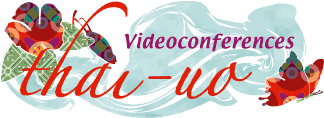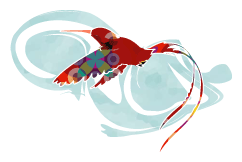Archived Series – Critical Thinking 2
 |
||
 |
Documents |
2004-05 Archived
|
Videos |
2004-05 Archived
|
2004-05 Archived Series – February 18, 2005
Critical Thinking Across the Language Curriculum, Part II
Cynthia Kieffer and Leslie Opp-Beckman, Speakers
February 18, 2005
Overview
This is the fourth lecture in a 10-part professional development series for English as a Foreign Language educators in Thailand. University of Oregon is partnering with the US Embassy in Bangkok, the Royal Thai Distance Learning Foundation, colleagues at Chulalongkorn University, and at ThaiTESOL on this innovative and exciting project.
This is the second of two parts on Critical Thinking Skills. The pedagogy of Critical Thinking in the language classroom is introduced as Part I in the third session on January 21, 2005. The focus for this second session is on the applied or practical side of integrating Critical Thinking into the language learning curriculum.
About the Speakers
Cynthia Kieffer is a Senior Instructor at the UO’s American English Institute. For an overview of a class she has taught on this subject, visit her Critical Thinking Skills site.
Leslie Opp-Beckman is on faculty at the University of Oregon in the Linguistics Department and the American English Institute. She develops e-learning curriculum and and teaches courses on Computer-Assisted Language Learning.
Discussion Questions
- I teach a grammar class. Is it possible to teach critical thinking in a grammar class?
- If we want our students to develop critical thinking skills, does it mean we have to redo the curriculum?
- How long will it take for critical thinking to become a natural process for my students?
- I teach a content class. There is a lot of content for students to learn and be tested on. How can I justify the time spent on critical thinking skills and activities?
Online Resources
Overview
This session combined critical thinking skills with the theme or content area of Shakespeare’s well-known story (play) Romeo and Juliet. See Post-lecture Classroom Applications below for more on this topic.
We also explored the concept of thinking and seeing “differently” through the use of optical illusions. For examples of the kinds of optical illusions that appeared in the PowerPoint presentation, see:
Readings
This session shares many of the same readings with the Part I session from January 21, 2005. They are listed in order of importance for this session. If you have time to read only one, please start with the first one.
- The Critical Thinking Community
The Center For Critical Thinking has broken the global concept of critical thinking down into 35 aspects or instructional strategies. For a 2-page summary, see: Strategy List: 35 Dimensions [MS Word document]. - Taxonomy of Socratic Questioning
This table has been adapted from: Paul, Richard, Critical Thinking: How to Prepare Students for a Rapidly Changing World, 1993. It is an example of Socratic questioning to probe students for reasons and evidence. - Teaching Thinking Skills, Kathleen Cotton
This research paper addresses the importance of teaching students to think critically and creatively, and provides an overview of critical thinking definitions. Included is a summary of research findings in areas such as the teaching of critical thinking skills and academic achievement, and the controversies in thinking skills instruction. Notice the rich bibliography for additional readings. - Bloom’s Taxonomy
Benjamin Bloom created this taxonomy for categorizing level of abstraction of questions that commonly occur in educational settings. The taxonomy provides a useful structure in which to categorize test questions. If you can determine the levels of questions that appear on your exams (look at the question cues), you will be able to identify if you are asking students to think critically. - Learning Domains or Bloom’s Taxonomy
http://www.nwlink.c
These charts summarize the three types of learning or domains of educational activities: cognitive, affective, and psychomotor. • Taxonomy of Socratic Questioning
http://www-ed.fnal.gov/trc/tutorial/taxonomy.html
The following table has been adapted from: Paul, Richard, Critical Thinking: How to Prepare Students for a Rapidly Changing World, 1993. It is an example of Socratic questioning to probe students for reasons and evidence.
Post-lecture Classroom Applications
Following are some supporting classroom websites related to the example story and film(s) from this session–Romeo and Juliet. We chose this story because it is well known and the story itself is publicly and freely available. In addition, many teachers have already developed interesting class activities that you can use or adapt in your own classes. You can choose from among the following activities to develop one or more lesson plans using the Romeo and Juliet context. Or, as other literature-based ideas are available through these websites as well, choose something that is more relevant to your own class/es.
- Web English Teacher
Focus on William Shakespeare, Romeo and Juliet with great lesson plans and other teaching ideas. Many other Critical Thinking and Literature ideas available here. - Romeo and Juliet Theme Page
http://www.cln.org/themes/romeo_julie
Contains links to two types of resources related to the study of Shakespeare’s Romeo and Juliet. Students and teachers will find curricular resources (information, content, etc.) to help learn about this topic. In addition, there are also links to instructional materials such as lesson plans, which will help teachers provide instruction on this theme. - EdSitement, ‘You Kiss by the Book’: Shakespeare’s Romeo and Juliet
Lesson plans and teaching ideas for Romeo and Juliet. Other links also available for Critical Analysis, Comparisons, Literary Interpretation, and more. - Lesson Plans
Classroom activities for group discussion, pair work, and integrated skills. - Integrating Shakespearian Tragedy with the Internet
An interdisciplinary unit that challenges students to use William Shakespeare’s Romeo and Juliet as a springboard to implement the following skills: basic skills, communication, inquiry, problem solving, synthesis, and critical thinking. - Teachers.Net Lesson Bank, Category-Literature
Lesson plans from other teachers for Romeo and Juliet and many other stories and poems. - Literature/Language Arts Lesson Plans and Resources
A directory of resources for Shakespeare’s plays, including Romeo and Juliet. - Clicknotes, Shakespeare Navigator
A directory of lesson plans and activities.
For more on lesson plan archives, look for the teacher trainer handout on Lesson Plans.